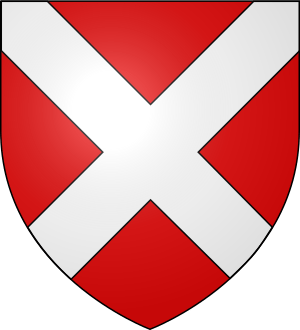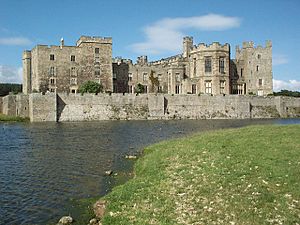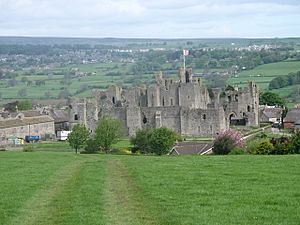Neville–Neville feud facts for kids
Quick facts for kids Neville family feud |
|||||||
|---|---|---|---|---|---|---|---|
| Part of fifteenth-century England | |||||||
 Neville family coat of arms; this was worn by the senior branch, whilst Salisbury's—as a younger son—would have been differenced. |
|||||||
|
|||||||
| Belligerents | |||||||
| Commanders and leaders | |||||||
The Neville–Neville feud was a big disagreement over who should inherit land and titles in the north of England. It happened in the early 1400s between two parts of the powerful Neville family.
The fight started because of Ralph Neville, 1st Earl of Westmorland. He was an important nobleman who had children from two marriages. Ralph preferred the children from his second wife, Joan Beaufort, to be his main heirs. Joan was closely related to the royal family. This meant he favored them over the children from his first wife, Margaret Stafford.
After Ralph Neville died in 1425, many family lands were legally given to Joan Beaufort's children. This group was called the Middleham branch of the Neville family. This decision basically disinherited, or cut off, the older branch of the family, known as the Nevilles of Raby. This led to more than ten years of fighting between the two family groups.
Ralph Neville's oldest son, John Neville, had died before his father. So, John Neville's son, also named Ralph, became the 2nd earl of Westmorland. Even though the title of Earl of Westmorland went to the older Nevilles, many important lands, especially in Yorkshire and Raby Castle in Durham, were given to Joan and her children. The Beaufort Nevilles also gained more control in County Palatine of Durham when Robert Neville became the Bishop of Durham in 1437.
The older branch of the family argued against losing their inheritance. They used both legal actions and force. But Joan Beaufort's oldest son, Richard Neville, won out. This was because his family had stronger political connections. The feud continued through the 1430s until an agreement was reached in 1443. This agreement mostly favored Salisbury. The two branches of the family remained unhappy with each other. The dispute even carried on into the Wars of the Roses. During this long civil war, the older branch supported the Lancastrians, while their cousins supported the Yorkists.
Why the Feud Started
Fights over who inherited property were common in medieval England. Besides the Neville family, similar disputes happened in the Talbot and Mountford families. Historian Michael Hicks said these three fights, where property moved from an older family line to a younger one, were "particularly large scale and high profile."
Ralph Neville, the 1st Earl of Westmorland (who lived from about 1364 to 1425), was married twice. His first wife, Margaret Stafford, died in 1396. Soon after, Ralph Neville married Joan Beaufort. She was the daughter of John of Gaunt and a cousin of King Richard II. Joan and Ralph had 9 sons and 5 daughters together. Their oldest son, Richard Neville, became earl of Salisbury. Their second son, William Neville, became earl of Kent. Other sons also gained important titles. Historian Anthony Tuck wrote that this marriage "was to have major consequences" for the Neville family and for English nobles throughout the 15th century.
Ralph Neville became an earl of Westmorland in 1397. This happened because he was now close to the royal family through his marriage to King Richard II's cousin. He also showed loyalty to the King during a difficult time. Joan and Ralph received many important jobs, lands, and money from the King. They continued to have royal favor until King Henry IV died in 1413.
The Neville family's original lands were in Yorkshire, Durham, Westmorland, and Cumberland. After marrying Joan Beaufort, Ralph Neville started a legal process to give less to the children from his first marriage. This process was called enfeoffment, which meant he legally transferred property. The earl's oldest son, John Neville, had already agreed to a plan where he would only inherit Raby Castle and Brancepeth Castle in Durham. This transfer of property to the younger branch of the family meant the older branch was almost completely disinherited. This was done legally, so the older Nevilles had no easy way to fight it in court.
This process of transferring property, sometimes called the "Neville trust," was designed by William Gascoigne. He was a very important lawyer for the king. This might show that the king was interested in keeping the Neville lands with Joan Beaufort's descendants. They were closely related to the royal family because they shared ancestors with the Lancastrian kings.
How the Dispute Unfolded

When Ralph Neville died in 1425, the title of Earl of Westmorland went to his oldest grandson, Ralph. But neither of Ralph's sons from Margaret Stafford were mentioned in his will. Joan immediately took control of Middleham Castle, Penrith Castle, and Sheriff Hutton Castle for her oldest son. She also held Raby Castle in Durham as part of her dower (a widow's share of her husband's property) until she died in 1440. Historian J. R. Lander wrote that the second Earl of Westmorland was "poor in land" compared to his father.
Only a few estates in Brancepeth, Northumberland, Lincolnshire, and some properties in London and Newcastle upon Tyne, Bywell Castle, and Ripon were left for the older Neville family. The large Yorkshire properties of Middleham Castle, Sheriff Hutton Castle, and Wensleydale all went to Richard Neville. He also became Warden of the West March when he inherited the Honour of Penrith in Cumberland. His wife, 15-year-old Alice Montagu, was the only heir of the late Earl of Salisbury. So, Richard also inherited the title earl of Salisbury in 1428 when his father-in-law died in the Hundred Years' War.
The Earl of Westmorland spent much of his life trying to get back the properties at Middleham, Sheriff Hutton, Penrith, and Raby. But he was mostly unsuccessful. This was because Joan Beaufort had powerful friends among the nobles. These included Thomas Langley, the Bishop of Durham, and her brother Cardinal Beaufort. Bishop Langley did not give the second earl any official jobs or positions in the county palatine (a special type of county).
Westmorland made legal promises to the Beaufort-Nevilles in 1430. This happened after Salisbury brought the issue to the King's council. When Salisbury left to fight in the Hundred Years' War in 1431 and again in 1436, Westmorland was again forced to promise to keep the King's peace. However, in 1435, complaints from the North reached the Lord Chancellor. They said the dispute between the older and younger Neville branches had led to large groups of armed men gathering. These groups were causing "great offences."

When the Bishop of Durham died in 1437, Cardinal Beaufort used his influence with the king's council. He helped Joan's younger son, Robert Neville, become the new bishop. The House of Beaufort slowly gained more control over the lands. By 1441, Salisbury's younger brother, Lord Fauconberg, was the manager and military leader of Durham. There were several attempts to settle the dispute through a council. Between 1441 and 1443, both sides were legally bound not to enter each other's estates without permission. Historian R. L. Storey wondered if Westmorland ever trusted the council to be fair, since Salisbury was such an important member of it.
What Happened Next
A peace agreement was finally made between Salisbury and Westmorland on August 26, 1443. Historian Pollard wrote that this "settlement" was a "crushing defeat" for Ralph II. He said that the odds were heavily against him from the start. Ralph II was confirmed in his right to the Lordship of Raby Castle. But he had to give up everything else he had claimed from Salisbury back to him. He also had to promise, with a large sum of money (£400) as a guarantee, to stick to the agreement in the future. This promise was not just to Salisbury, but to his four brothers as well. Westmorland had to give up all claims to the Neville lands in County Durham. He also had to pay yearly rents to Salisbury for various properties in Northumberland. Salisbury did not have similar strict rules. He only had to agree not to claim the £400 payment if Westmorland followed their agreement.
J. R. Lander said the Neville–Neville feud showed how the Neville family "never could and never did work together." The dispute between the older and younger branches of the Neville family continued into the Wars of the Roses. During this long civil war, Westmorland gave his half-brother no support at all. In fact, Westmorland's younger brother, Lord John Neville, died fighting for the Lancastrian Henry VI at the Battle of Towton in 1461. Salisbury himself was captured at the Battle of Wakefield. Instead of being held for ransom, as was common, he was killed by the common people. Lander also suggested that if the family had been united behind Salisbury, who supported Richard of York during the Wars of the Roses, York's "power in the land would have been overwhelming."
See also
- Bonville–Courtenay feud
- Berkeley-Lisle feud



